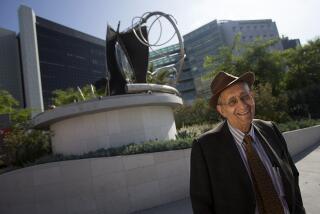Victor Vasarely; Leading Op Art Painter
PARIS — Victor Vasarely, whose strong geometric designs and use of optical illusions made him a master of Op Art, has died at age 90. His final years were soured by the financial misdeeds of a foundation carrying on his work.
The Hungarian-born painter had suffered from prostate cancer for the past two years and died Saturday night at a private Paris clinic, said his daughter-in-law, Michele Vasarely.
She said her father-in-law’s decline in health coincided with the financial and legal woes of his Vasarely Foundation, which was scheduled to be dissolved at the end of the month.
One of the last survivors of the German Bauhaus school that emphasized functionalism, Vasarely designed everything from champagne bottles to university buildings. But it was his abstract works, with their combination of bright colors and geometrical forms, that brought him fame.
“Vasarely was the pope of Op Art and kinetic art,” said Jozsef Sarkany, art historian at the Vasarely Museum in Pecs, Hungary, where the artist was born. “He thought that everybody is an artist.”
Born on April 9, 1906, Vasarely deftly wielded pen and paper by the age of 7. As a young man, he entered medical school but quit in 1927 to study art.
Vasarely was a regular visitor to the studio of Sandor Bortnyik, one of Hungary’s leading artists between the wars. There he was introduced to the works of Kandinsky, Le Corbusier and Chagall.
In 1930, Vasarely moved to Paris, where he earned a living producing graphic designs and honing techniques that would help define his aesthetic code.
By 1947, Vasarely was part of an elite group of artists who believed contemporary art should integrate the advances of science and technology.
Experimenting with Expressionism, Cubism, then surrealism, Vasarely in 1955 launched into so-called optical art, based on creating optical illusions. The technique gave perspective to his colored geometric visions.
Among Vasarely’s best-recognized works is a three-dimensional portrait of President Georges Pompidou, an avid admirer, hanging at the Beaubourg Center in Paris.
In 1971, Pompidou’s widow inaugurated the Vasarely Foundation in Aix-en-Provence, where 32 monumental-sized works of artists are exposed.
But several years of court battles over the fate of the foundation, whose funds were mismanaged, left Vasarely and his family bitter. The director was imprisoned for several weeks amid allegations of abuse of confidence, and the foundation was to be dissolved at the end of this month.
In a recent letter to President Jacques Chirac, Michele Vasarely and the painter’s two sons, Andre and Jean-Pierre, wrote that the artist was going to die “confronted with loss and ingratitude.”
Chirac answered the letter, Michele Vasarely told AP, but “it was too late.”
More to Read
The biggest entertainment stories
Get our big stories about Hollywood, film, television, music, arts, culture and more right in your inbox as soon as they publish.
You may occasionally receive promotional content from the Los Angeles Times.










